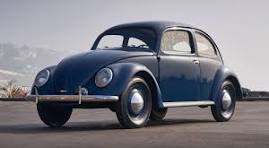On January 17, 1949, the iconic Volkswagen Beetle made its official debut in the United States, marking a significant moment in automotive history. The Beetle, originally known as the Volkswagen Type 1, was designed by Ferdinand Porsche at the request of Adolf Hitler in the 1930s. However, it wasn't until after World War II that the Beetle gained international popularity as a symbol of affordability, reliability, and practicality. The post-war era presented a unique set of challenges for Germany, and the Volkswagen Beetle emerged as a testament to the country's resilience and ingenuity. The car's design was simple yet innovative, featuring a distinctive rounded shape that would go on to become one of the most recognizable silhouettes in the automotive world. The Beetle's engineering was equally impressive, with an air-cooled rear-engine and a sturdy chassis, making it well-suited for a variety of driving conditions. The arrival of the Volkswagen Beetle in the United States in 1949 marked a new chapter for the automotive industry. At the time, American car manufacturers were producing large, heavy vehicles with powerful engines. The Beetle, in contrast, offered a compact, fuel-efficient alternative that appealed to post-war sensibilities and the growing desire for practical transportation. Initially met with skepticism, the Beetle quickly won over American consumers with its charming design and impressive reliability. Its affordability also played a crucial role in its success, making it accessible to a wide range of buyers. Over the years, the Beetle became a cultural icon, associated with the counterculture movements of the 1960s and 1970s. Throughout its production history, the Volkswagen Beetle underwent several modifications and improvements, but its core design remained remarkably consistent. The Beetle's appeal transcended generations, and its quirky charm resonated with people around the world. It became more than just a car; it became a symbol of individuality and a cultural icon that left an indelible mark on the automotive landscape. In 1972, the Volkswagen Beetle surpassed the Ford Model T as the best-selling car model in the world, solidifying its status as a global phenomenon. Production continued for decades, with the last original Beetle rolling off the assembly line in Mexico in 2003. Despite this, the Beetle's legacy endured, and in 2011, Volkswagen introduced the modernized Beetle, paying homage to its iconic predecessor while incorporating contemporary features. The January 17, 1949, debut of the Volkswagen Beetle in the United States marked the beginning of a journey that would see the little car become a symbol of innovation, resilience, and adaptability. Its impact on the automotive industry was profound, paving the way for the development of compact, fuel-efficient cars and influencing the design and marketing strategies of countless manufacturers. The Beetle's timeless design and enduring popularity serve as a testament to the power of innovation and the ability of a small car to leave an outsized imprint on the world.
17 January 1949 Volkswagen Beetle
